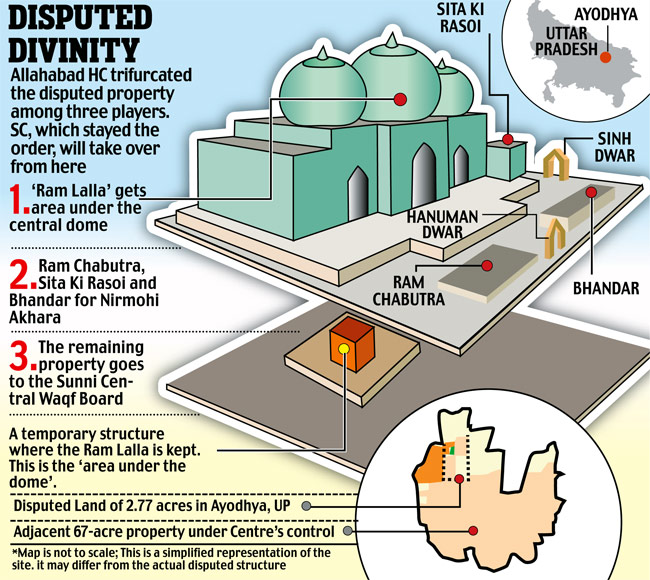What is the issue?
With the Supreme Court beginning the final hearings in the Babri-Masjid Case, it is vital to understand the progress of events.
How did the controversy evolve?
- Chabutra - Chabutra was an uncovered open platform adjoining the Babri Masjid, in Ayodhya, UP.
- Hindu priests wanted a temple constructed on the Chabutra to be able to conduct their worship without vagaries of weather.
- In 1885, a civil suit was filed, seeking permission to construct a temple over the Ram Chabutara spot.
- The Chabutara and Sita Rasoi, worshipped by the Hindus, fall within the ‘outer courtyard’ in a disputed 2.77 acres.
- This was separated from the inner courtyard, where the Babri Masjid stood, by a brick wall with iron grills.
- This apparent territorial confusions led to the Hindu-Muslim tensions escalating.
- The Faizabad sub-judge dismissed the suit on the grounds that granting permission to construct a temple would lead to riots.

- Idols - Despite intermediate riots in Ayodhya, the status quo largely continued till December, 1949.
- But in December, 1949 a group installed idols inside what they claimed was the disputed structure, and puja was started.
- The state government wanted the idols removed.
- But the Faizabad district administration felt that doing so would lead to communal violence.
- Litigations - Resultantly, the next round of litigations began in 1950.
- A resident of Ayodhya filed a title suit before the Civil Judge in Faizabad.
- It claimed that the right to worship was being impeded by the state government.
- The suit also sought a permanent restriction to prohibit the removal of the idols.
- Various other suits were also filed by Muslim boards and individuals claiming that the Babri Masjid was built by Mughal emperor Babur.
- To the High Court - Countering the claims were those of the Hindu religious groups, stating that Babur had destroyed the Janmasthan temple in 1528 and built a mosque in its place.
- Thus the site became a source of claims and counterclaims on the ownership of the disputed area.
- Subsequent to the dispute, the cases were transferred to the Allahabad High Court.
- Meanwhile, the Civil Judge, in January, 1950, passed an interim order restraining the removal of the idols.
- Thus the puja continued and the public allowed for darshan from beyond the brick-grill wall.
- Following appeals, an order was passed to open the locks on the brick-grill wall and allow darshan from inside.
- Ram temple - Following the order, the Babri Masjid Action Committee (BMAC) sought the restoration of the disputed structure to the Muslims.
- As the BMAC launched a protest movement, Hindu organisations also began to mobilise public opinion.
- They were in favour of constructing a Ram temple at the disputed site.
- The order thus triggered a chain reaction, leading to the demolition of the structure on December 6, 1992.
- Acquisition - Meanwhile in 1991, the Uttar Pradesh government acquired 2.77 acres of land, including the premises in dispute.
- This, it said, is for the “development of tourism and providing amenities to pilgrims in Ayodhya”.
- However, five days after the demolition in 1992, the High Court quashed this order.
- Subsequently, in 1993, the central government acquired 67.7 acres under the ‘Acquisition of Certain Area at Ayodhya Ordinance, 1993, later replaced by an Act.
- Later, the Supreme Court, examining the validity of the acquisition Act, struck it down as unconstitutional.
- Survey - Oral evidence was recorded and various reference books were presented between 1996 to 2007.
- The Allahabad HC, in 2003, directed the Archaeological Survey of India to excavate the area.
- In its report, the ASI described “remains which are distinctive features found associated with the temples of north India”.
- Allahabad HC verdict - In September, 2010 the Allahabad HC ordered a three-way division of the disputed 2.77 acres.
- It gave a third each to the Nirmohi Akhara sect, the Sunni Central Wakf Board, UP, and Ramlalla Virajman (infant Lord Ram, the presiding deity in the temple).
- It was however, a 2-1 majority judgement.
- The majority judges held that the disputed structure was raised on an existing structure, the remains of which were used in constructing the new structure.
- It was also mentioned that the erstwhile structure was a Hindu temple and it was demolished whereafter the disputed structure was raised.
- The minority judge held that that no temple was demolished but the mosque was constructed over the ruins of temples.
- Riots and thereafter - After the demolition in 1992, the CBI lodged two FIRs on charges of promoting enmity between groups.
- Charges were also filed against some politicians, charging them with criminal conspiracy and acting deliberately to outrage religious feelings.
- Later in 2011, the Supreme Court ordered status quo on the disputed site and adjoining 67.7 acres of land acquired by the Centre.
- Recently, in August, 2017 the court gave the parties 12 weeks to translate all oral evidence and exhibited documents in various languages.
- The process is now complete and the Supreme Court will start final hearings on cross-appeals against the HC order.
Source: Indian Express
